The Original Silver Beaver
The Silver Beaver Award was established in 1931 an was presented to registered male Scouters
for their distinguished service to young people within a local Boy Scouts of America council. It
was, and still is, the highest national award which may be presented by a local council.
The Silver Beaver was introduced in 1931 as a pin-on medal, but due to the heavey weight of the medallion it was switched over to a neck ribbon in mid-1932. A blue-white-blue ribbon bar was introduced in 1934 for informal uniform wear. In 1946, the ribbon bar was replaced by the current knot insiginia.
The Silver Fawn
In 1969, a study was conducted by the BSA on the subject, "Awards for Women." One of the results
of this study was the creation of the "Silver Fawn Medal." It was introduced in 1971 for use at
the council level and was designed to be the women's equivalent of the Silver Beaver Award, which
since 1931 had gone to male Scouters who had made outstanding contributions to Scouting at the
local council level.
The original medal was a solid silver mule deer fawn in a 'seated' posture suspended from a
green and white ribbon. The silver fawn is approximately 1.25" wide and .75" high. The ribbon
is 1" wide x 20" long and is equally divided into green and white colored fields.
In 1974, the BSA discontinued this award and merged it into the Silver Beaver award, to
recognize all volunteers equally.
The Silver Beaver (today)
Annually, volunteers nominate men and women who are doing an outstanding job as Scouters
for the Silver Beaver award. These nominations are reviewed by the Council Awareds Committee
each year and the most outstanding Scouters are selected to receive this special recognition. The committee welcomes all nominations and encourages everyone to recommend those Scouters you believe worthy of this high honor.

